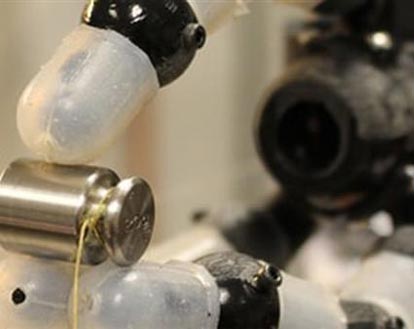A team of researchers from Carnegie Mellon University have developed a 3D printed, three-fingered robotic hand with fiber optical sensors that are stretchable. The hand is able to detect forces that are less than a tenth of a newton.
“Using fiber optics, the team of researchers placed 14 strain sensors into each of the robot’s fingers, which are closely modeled on the skeletal structure of a human finger. Each finger has a 3D-printed plastic fingertip, middle node and base node connected by joints and covered in a silicon rubber skin. This technology provides the robotic hand with the ability to determine where its fingertips are in contact and to detect even minuscule forces. Although the new stretchable optical sensing material has not been incorporated in the current version of the hand, researchers are hopeful that it could be used in a future soft robotic skin to provide greater feedback,” according to 3ders.org.
Using pressure or force sensors can be a problem because wiring becomes complicated and the sensors are easily broken. The sensors are also extremely vulnerable to electromagnetic interference from electric motors and interference from other electromagnetic devices.
“A single optical fiber can, on the other hand, contain several sensors. All of the sensors in each of the fingers of the partially 3D-printed robotic hand are connected with four fibers, and are completely resistant to electromagnetic interference,” researchers noted.
Researchers are optimistic that this technology will increase autonomy in robotics.
“If you want robots to work autonomously and to react safely to unexpected forces in everyday environments, you need robotic hands that have more sensors than is typical today. Human skin contains thousands of tactile sensory units only in the fingertip and a spider has hundreds of mechanoreceptors on each leg, but even a state-of-the-art humanoid such as NASA’s Robonaut has only 42 sensors in its hand and wrist,” Yong-Lae Park, assistant professor of robotics at Carnegie Mellon, said.
“The device incorporates commercially available fibre Bragg grating (FBG) sensors, which detect strain by measuring shifts in the wavelength of light reflected by the optical fibre. The finger is bent by a single active tendon, while a passive elastic tendon provides opposing force to straighten the finger,” according to 3ders.org.
The research team believes the new sensor could be used in the future to improve robotics.
